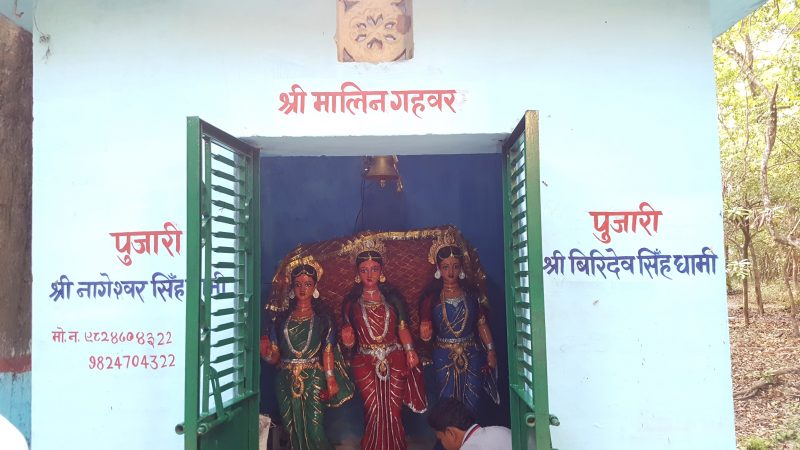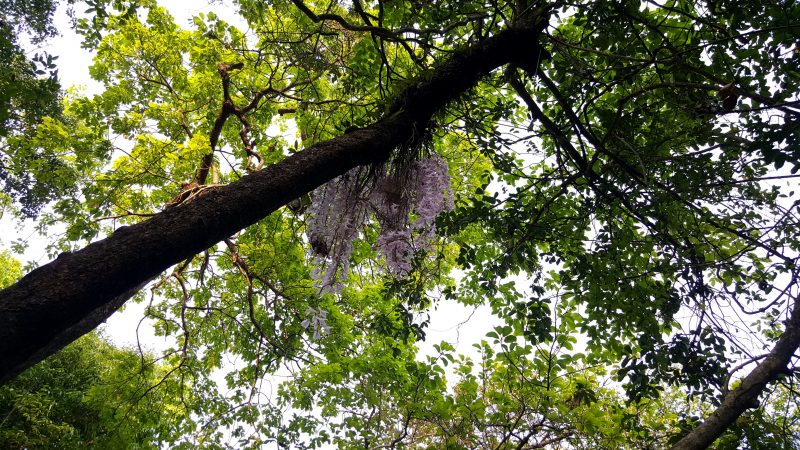
Shrine dedicated to gardener sisters whom Salahesh used to meet at the Salahesh fulbari in Siraha district of eastern Nepal. Image by Sanjib Chaudhary.
An orchid that blooms around mid-April in a garden of historical and cultural significance in Siraha, eastern Nepal attracts hordes of pilgrims from both India and Nepal every year.
The locals in the area of the garden, known as the Salahesh Fulbari, believe that the flower blooms on the very first day of the year, 1st of Baishakh (the first month in the Nepali Calendar). According to legend, the orchid symbolizes the garland offered to the folk hero Salahesh by his beloved malin (a Maithili word for a female gardener).
Strange flower!
A flower that blooms only on the New Year 1st of Baishakh at the historical and ancient garden located in the south of Siraha’s Padariya Chowk on the East-West Highway. The orchid blooms on the haram tree in the Salahesh Garden early in the morning and wilts in the evening. Photo: RSS (National News Agency)
Fascinating folklores, cultural demigod
Not much has been written about Salahesh, also known as Sailesh (the king of mountains) and Jayavardhan. However, in the southern plains of eastern Nepal and adjoining states in Bihar of India, there are many folklore stories featuring Salahesh and his adventures. Different versions of folktales handed down from one generation to the other talk about Salahesh’s bravery and his love for his malin.
According to one legend, Salahesh used to visit the Salahesh Fulbari to pick flowers for use in religious rituals after performing his ablutions. He would meet four sisters who were gardeners there, and in due course, he fell in love with one of them. The orchid which blooms in mid-April every year, according to locals, symbolizes that love. Young couples visit the garden on the Nepali New Year’s Day to receive blessings for their love and express hope that their love would last long just like that of Salahesh and his gardener love.
According to many stories about Salahesh, he was a Dusadh, a member of the so-called untouchable community. He is also claimed, however, by the Danuwar community. But Salahesh is worshipped by all, irrespective of caste and ethnicity. With time, he has evolved for several communities from a Dalit hero into a demigod.
Mythology versus science
While hundreds of thousands of pilgrims flock to the Salahesh Fulbari each year to get a glimpse of the famous flower and worship Salahesh and malin, science says something else.
Although the locals claim that the flower blooms in the early morning on the 1st of Baishakh and wilts in the evening, the orchid blooms appear before the onset of the New Year.

This picture of the orchid was clicked four days ahead of the 1st Baishakh, the first day of the New Year. Image by Sanjib Chaudhary.
The Nepali government’s Department of Plant Resources have identified the flower as the orchid Dendrobium aphyllum (Roxb.) C.E.C. Fisch, and the famed tree on which the flowers bloom as Bischofia javanica Blume or bishopwood, locally known as haram.
Also known as hooded orchid, this species was discovered by William Roxburgh in southern India. It is found in India, Nepal, Bhutan, Burma, China, Thailand, Laos, Cambodia, Vietnam, and Malaysia.
While the myth about the flower’s species and the timing of its blooming and subsequent wilting in the Salahesh Fulbari has been busted, deep-rooted faith and obeisance to demigod Salahesh keep people from visiting the garden before and after the Nepali New Year’s Day. And they continue flocking to the Salahesh Fulbari to see this strange and legendary flower that blooms early in the morning and wilts in the evening, only on the 1st day of the Nepali New Year, as per their belief.